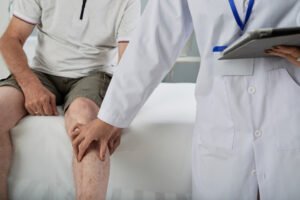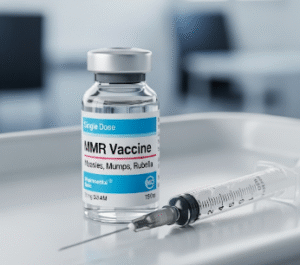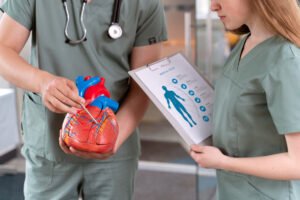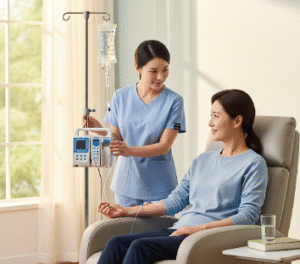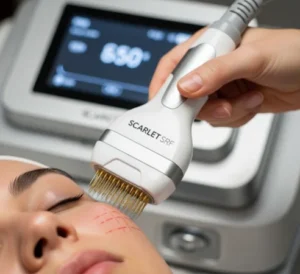➤ Overview
A tremor is an involuntary, rhythmic shaking of a part of the body, commonly affecting the hands, arms, head, voice, or legs. Tremors can vary in frequency, amplitude, and triggers, ranging from mild and occasional to severe and disabling. They may occur as an isolated neurological issue or as a symptom of underlying medical conditions such as Parkinson’s disease, hyperthyroidism, or medication side effects.
In South Korea, tremor evaluation is conducted by neurologists and movement disorder specialists using clinical examination, imaging, and electrophysiological testing. Early diagnosis is critical to identify the cause, manage symptoms, and improve quality of life.
➤ Key Facts
→ Tremors are involuntary rhythmic movements that may worsen with stress, fatigue, or certain positions.
→ They can be action tremors (during movement) or resting tremors (when muscles are relaxed).
→ Common causes include neurological disorders, medications, metabolic conditions, and lifestyle factors.
→ Tremors may be benign or indicative of serious disease, depending on pattern and associated symptoms.
→ In Korea, treatment combines medical management, physical therapy, and advanced neurological interventions.
→ Tremors may affect daily activities such as writing, eating, and speaking, impacting independence and quality of life.
→ Early assessment can prevent progression and provide targeted treatment.
➤ What is Tremor?
A tremor is an involuntary shaking movement caused by irregular nerve or muscle activity:
→ Resting tremor – Occurs when muscles are relaxed, often associated with Parkinson’s disease.
→ Action tremor – Appears during voluntary movement, such as reaching for objects.
→ Postural tremor – Observed when maintaining a position against gravity.
→ Intention tremor – Becomes more pronounced as a target is approached, often linked to cerebellar disorders.
→ Physiologic tremor – Mild, normal shaking that can increase with stress, fatigue, or stimulants.
→ Essential tremor – Common, often hereditary, affecting hands and head, typically worsening with age.
→ Tremor severity ranges from occasional mild shaking to continuous disabling movements.
➤ What Symptoms are Related to Tremor?
Tremors can be accompanied by other neurological, systemic, or lifestyle-related symptoms:
→ Muscle stiffness or rigidity → Often seen in Parkinson’s disease.
→ Difficulty with fine motor tasks → Writing, buttoning clothes, or holding utensils.
→ Head or voice tremor → Shaking of the head or tremulous speech.
→ Balance and coordination issues → Especially with cerebellar or intention tremors.
→ Fatigue → Tremor may worsen with tiredness or prolonged activity.
→ Stress or anxiety-related worsening → Emotional triggers can exacerbate tremors.
→ Medication side effects → Tremor may accompany other drug-related neurological symptoms.
→ Systemic signs – Hyperthyroidism can cause tremor with palpitations, sweating, and weight loss.
➤ What Causes / Possible Causes?
Tremors have diverse causes, ranging from benign to serious medical conditions:
→ Neurological disorders – Parkinson’s disease, multiple sclerosis, cerebellar degeneration.
→ Genetic or hereditary factors – Essential tremor often runs in families.
→ Medications and substances – Stimulants, corticosteroids, antidepressants, or withdrawal from alcohol.
→ Metabolic or endocrine disorders – Hyperthyroidism, hypoglycemia, or electrolyte imbalance.
→ Stress, fatigue, or anxiety – Can exacerbate physiologic tremors.
→ Caffeine or stimulant use – Temporary increase in shaking.
→ Peripheral neuropathy – Nerve damage affecting motor control.
→ Structural brain lesions – Stroke, tumor, or trauma affecting cerebellum or basal ganglia.
→ Age-related changes – Mild tremor can occur with aging even without disease.
➤ When Should I See My Doctor?
Medical evaluation is recommended if tremors are:
→ Persistent, progressive, or worsening over time.
→ Interfering with daily activities such as eating, writing, or speaking.
→ Associated with other neurological symptoms – Weakness, stiffness, or coordination problems.
→ Linked to systemic symptoms – Palpitations, sweating, or weight changes.
→ Sudden in onset – Could indicate stroke, trauma, or metabolic imbalance.
→ In Korea, neurologists and movement disorder specialists provide comprehensive evaluation using clinical, laboratory, and imaging studies.
➤ Care and Treatment
Treatment depends on type, severity, and underlying cause:
→ Lifestyle adjustments – Reduce caffeine, manage stress, improve sleep, and avoid triggers.
→ Physical and occupational therapy – Enhance motor control, coordination, and adaptive strategies.
→ Medications – Beta-blockers, anticonvulsants, or dopaminergic drugs depending on tremor type.
→ Treatment of underlying conditions – Thyroid management, diabetes control, or medication adjustment.
→ Surgical interventions – Deep brain stimulation for severe, medication-resistant tremors.
→ Assistive devices – Weighted utensils, stabilizing tools, or braces for daily tasks.
→ Regular monitoring – Track progression and response to therapy.
→ Patient education – Awareness of triggers, safe practices, and symptom management.
➤ Treatment Options in Korea
South Korea offers advanced neurological care and rehabilitation for tremor management:
Diagnosis in Korea
→ Neurological examination – Assess tremor type, frequency, amplitude, and triggers.
→ Electromyography (EMG) and nerve studies – Evaluate muscle activity and nerve function.
→ Imaging – MRI or CT scans to detect structural brain causes.
→ Laboratory tests – Thyroid function, electrolytes, or medication review.
→ Multidisciplinary evaluation – Collaboration with neurology, physiotherapy, and occupational therapy.
Medical Treatments in Korea
→ Pharmacologic therapy – Beta-blockers, primidone, or other tremor-specific medications.
→ Management of systemic disorders – Hyperthyroidism, diabetes, or metabolic imbalances.
→ Lifestyle and stress management programs – Reduce triggers and improve daily function.
Advanced Therapies in Korea
→ Deep brain stimulation (DBS) – For severe, medication-resistant essential tremors or Parkinsonian tremors.
→ Robotic-assisted rehabilitation – Enhance fine motor control and coordination.
→ Multidisciplinary care – Neurologists, physiotherapists, and occupational therapists working together.
→ Patient education programs – Focus on self-management, safety, and quality of life improvements.
Rehabilitation & Support in Korea
→ Ongoing monitoring for progression and treatment effectiveness.
→ Guidance on adaptive strategies and assistive devices for daily living.
→ Support for psychological well-being to reduce anxiety or depression associated with chronic tremors.




